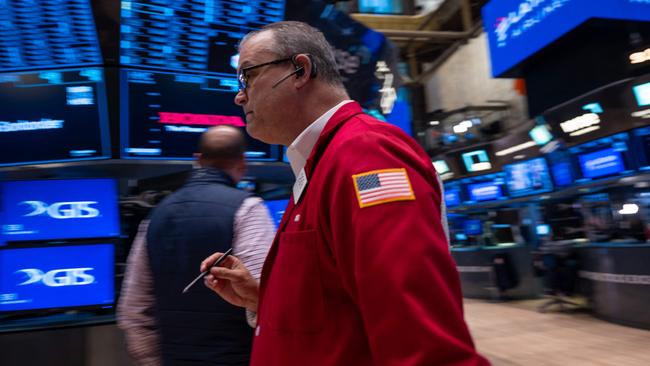US stocks best pick for 2025 but beware inflation rebound, says T. Rowe Price
The US stockmarket may struggle to repeat its stunning performance of the past year but should again be one of the best places to invest in 2025, according to T. Rowe Price.

Business
Don't miss out on the headlines from Business. Followed categories will be added to My News.
The US stockmarket may struggle to repeat its stunning performance of the past year but should again be one of the best places to invest in 2025, according to Thomas Poullaouec at T. Rowe Price.
With the US economy proving resilient to higher interest rates; US interest rates coming down as inflation cools; and fiscal stimulus and deregulation potentially offsetting supply-side risks from US immigration and trade policies, Mr Poullaouec expects the S&P 500 to return about 10 per cent in 2025.
Such a result would be in line with the average annual return of the S&P 500 since inception in 1957.
Mr Poullaouec heads multi-asset solutions Asia-Pacific for T. Rowe Price, an investment powerhouse with $US1.63 trillion ($2.55 trillion) of assets under management.
Founded in 1937, Baltimore-based T. Rowe Price is the world’s biggest active funds manager.
Considering that the US benchmark has risen about 50 per cent over the past two years on the back of massive gains in the so-called Magnificent 7 tech giants headed by Nvidia, most investors would be more than happy with a 10 per cent return in 2025. It could also be better than many other regions.
After rising 28 per cent year-to-date, the S&P 500 is trading on a pricey 12-month forward price-to-earnings multiple of about 22.3 times versus a 10-year average of about 18 times.
But the S&P 500 is expected to generate 10 per cent growth in earnings per share in aggregate next year.

Australia’s S&P/ASX 200 also trades on an expensive forward PE multiple of 18.2 times versus its long-term average of 14.7 times. However, S&P/ASX 200 earnings per share growth is expected to be barely positive. In order for the S&P/ASX 200 to rise in 2025, earnings growth would have to surprise positively, or the market would have to get even more expensive.
To be sure, the S&P 500’s rise has been narrowly based. Mag 7 stocks are expected to generate most of the earnings growth and potentially a fair bit of the index growth again next year. High cash levels also give them a lot of resilience in the event that interest rates stay relatively high.
Still, with the Fed cutting interest rates, mergers and acquisitions likely to rebound, and deregulation and tax cuts potentially helping US leveraged companies more than multinationals, Mr Poullaouec sees the rally broadening to value and mid-size companies.
But while some fund managers have recently argued the case for European stocks, T. Rowe Price has underweight ratings on European and Australian stocks versus overweight for the US.
The US fund manager remains overweight rated on large-cap value stocks, but also keeps its allocation to large-cap growth stocks in the global index via its overweight stance in the US market.
“US earnings growth has been primarily driven by the Magnificent 7,” Mr Poullaouec added.
“But with their earnings starting to slow from extreme levels on moderating AI spending, investors are beginning to look to the ‘other 493’ which are seeing encouraging signs of earnings growth.”
This broadening began in the second quarter and has continued into the third quarter on the back of better economic growth and easing monetary policy. While this is encouraging, the earnings growth forecast for the S&P 500 companies outside Mag 7 has only reached the low-single digits from negative levels, while Mag 7 growth is still forecast to be near 20 per cent.
But resilient economic growth, easing monetary policy, and potential changes in fiscal and regulatory policies could be tailwinds for the broader US stockmarket.
US financials, consumer discretionary and health care stocks are some of his favourite US sectors.

Mr Poullaouec does see relatively-high volatility in 2025 from policy uncertainty, particularly on the sequencing and intensity of Donald Trump’s policies, and also due to continued volatility in bonds, though that may cool as long as the Fed keeps cutting rates.
One risk is that the Fed stops cutting soon and goes on hold for an extended period as it did in 1995-1996.
Inflation risks from Mr Trump’s policies and a less dovish Fed would support the recent call by Arif Husain – the head of global fixed income and chief investment officer of the fixed income division at T. Rowe Price – for the 10-year US Treasury yield to rise to 5 per cent versus 4.15 per cent now.
“Bond vigilantes” could become a risk for stocks if yields move past 5 per cent; there is sustained large bond issuance; no plan to rein in the US budget deficit; and potentially a less-dovish Fed.
T. Rowe Price research shows that in 90 episodes of inflation going back about 100 years, it’s unusual to have just one inflation spike as there was during the pandemic.
“Typically we see two waves of inflation and they can take on average 14 months between the end of the first wave and start of the second wave,” Mr Poullaouec said.
“If you look at the level of cost and prices, they are still quite elevated compared to pre-pandemic.
“So people are asking for higher wages, and that’s with a job market that is still okay.
“The job market is still in favour of employees in terms of wage demand.
“So there could be a risk of inflation, especially so if there is an expectation that oil prices could go lower, but if you have Middle East tension, that’s also a wildcard that could push oil prices higher.”
But at this stage, he expects three more 25 basis point rate cuts by the Fed, which point to a sharply steeper yield curve if the 10-year yield does get back up to 5 per cent.
A recession is seen as unlikely. Taking account of the strength in the services sector and corporate earnings, T. Rowe’s recession probability estimate is in line with historical norms of 10-20 per cent.
Manufacturing could surprise on the upside due to low inventories, US infrastructure rebuilding needs and Mr Trump’s policy plans to deregulate the energy sector.
T. Rowe has an underweight view on government bonds as it sees yields moving higher on better economic global growth, driven by the US. It likes higher-yielding sectors including high yield bonds and emerging markets bonds but thinks investment grade will struggle amid tight spreads.
More Coverage
Originally published as US stocks best pick for 2025 but beware inflation rebound, says T. Rowe Price





